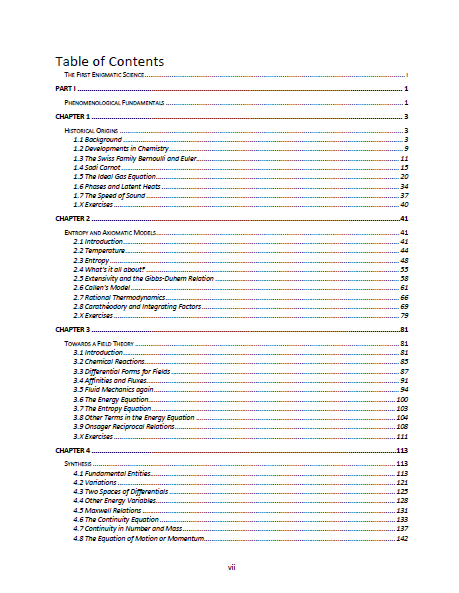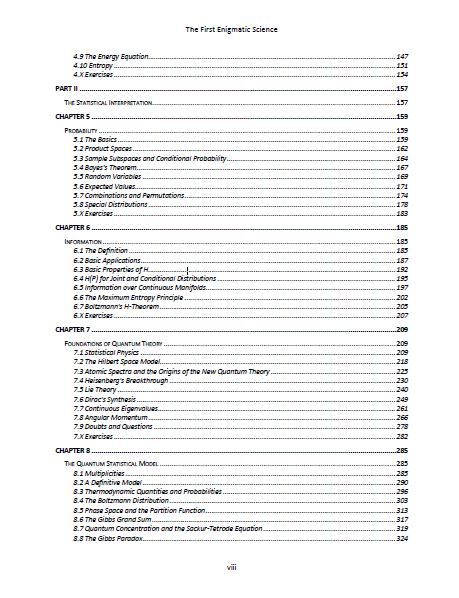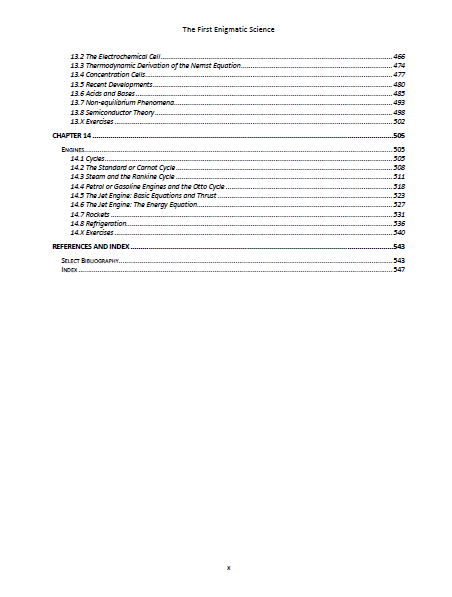Thermodynamics
ISBN 978-0-9935483-2-1
My text on Thermodynamics, an examination of the mathematical structure behind the subject, was completed and published in the late summer of 2019. It took a little longer than originally planned, partly because of other pressing work.
The book falls into three parts, the first dealing with the historical background (to which the entire first chapter is devoted) and the theoretical development up to and including the concept of the entropy state function, the introduction of which was only properly justified by Caratheodory some fifty years later. The development gives prominence to the non-equilibrium or microscopic model, in contrast to most basic texts which develop only the macroscopic or extensive variables form.
The second part develops the statistical mechanical interpretation of the subject, beginning with a fairly mathematically mature introduction to quantum mechanics, as the Bose-Einstein and Fermi-Dirac statistical models are crucial here. This part starts with a quick review of probability and information theory.
The third part covers much of the main “stuff” of most undergraduate courses, treating chemical reactions, phase changes and the phase rule, and electrochemistry before closing the book with a chapter on engines, leading up from piston engines through jet engines to rockets.
I’ve avoided being overly polemical in this book; most of thermal physics is fairly well accepted, but I do hint at some reservations about the introduction of concepts that were, especially at the time, not entirely justified by empirical results. In particular, I lay stress on E T Jaynes’s outstanding insight into the true significance of probabilistic concepts in physics.
The final Table of Contents appears below, and, FYI, below that appears the state of it in the summer of 2018!




Thermodynamics
ISBN 978-0-9935483-2-1
This was the state of the text when this website was being constructed in mid 2018. You can see that the entire framework of the book was already in place by this time (March 2018) although publication was not to happen until October 2019.
Table of Contents
Phenomenological Fundamentals 1
1.2 Developments in Chemistry 8
1.3 The Swiss Family Bernoulli and Euler 11
1.6 Phases and Latent Heats 33
2.2 Entropy − The Callen Model 39
2.3 Rational Thermodynamics 48
2.4 Further Development and the Gibbs-Duhem
Relation 51
2.5 Carathéodory and Integrating Factors 54
3.3 Differential Forms for Fields 62
3.8 Other Terms in the Energy Equation 76
3.9 Onsager Reciprocal Relations 78
The Statistical Interpretation 91
5.3 Sample Subspaces and Conditional
Probability 98
5.7 Combinations and Permutations 107
6.4 H(P) for Joint and Conditional
Distributions 127
6.5 Information over Continuous Manifolds 128
6.6 The Maximum Entropy Principle 133
Foundations of Quantum Theory 139
7.2 The Hilbert Space Model 145
7.3 Atomic Spectra and the Origins of the
New Quantum Theory 154
7.4 Heisenberg’s Breakthrough 158
7.7 Continuous Eigenvalues 187
The Quantum Statistical Model 205
8.3 Thermodynamic Quantities and
Probabilities 214
8.4 The Boltzmann Distribution 221
8.5 Phase Space and the Partition Function 228
8.7 Quantum Concentration and the
Sackur-Tetrode Equation 234
9.1 Introduction: Fermi-Dirac and
Bose-Einstein Statistics 239
9.2 A More Complete Analysis 242
9.3 The Classical Approximation 246
9.6 Bosons and Bose-Einstein Condensation 256
10.1 The Planck Radiation Law 261
10.2 Phonons and the Heat Capacities of
Solids 264
10.4 The Thermodynamics of Radiation 271
11.1 Internal and External Sources of
Entropy Change 277
11.2 A Deeper Look at Affinities 280
11.3 Pressures, Concentrations and
Activities 284
11.4 The Gibbs Free Energy 288
11.6 The van’t Hoff Equation 295
11.8 The Michaelis-Menten Mechanism 301
11.9 Chiral Symmetry Breaking and Chemical
Oscillations 307
12.2 Energy Changes with Change of Phase 319
12.4 The Critical Point Problem 322
12.5 Colligative Properties of Solutions 323
13.2 The Electrochemical Cell 330
13.3 Thermodynamic Derivation of the Nernst
Equation 336
14.2 The Standard or Carnot Cycle 358
14.3 Steam and the Rankine Cycle 361
14.4 Petrol or Gasoline Engines and the
Otto Cycle 368











